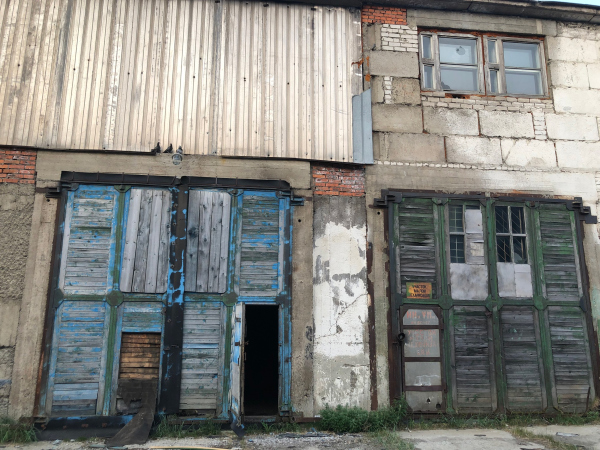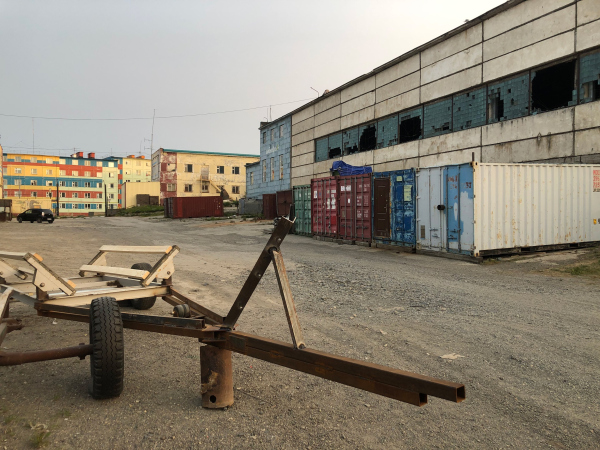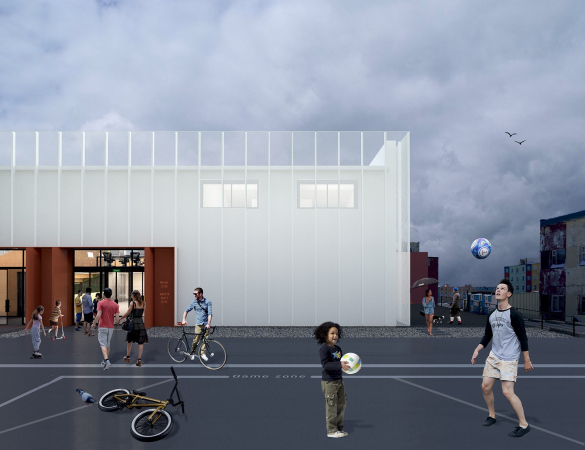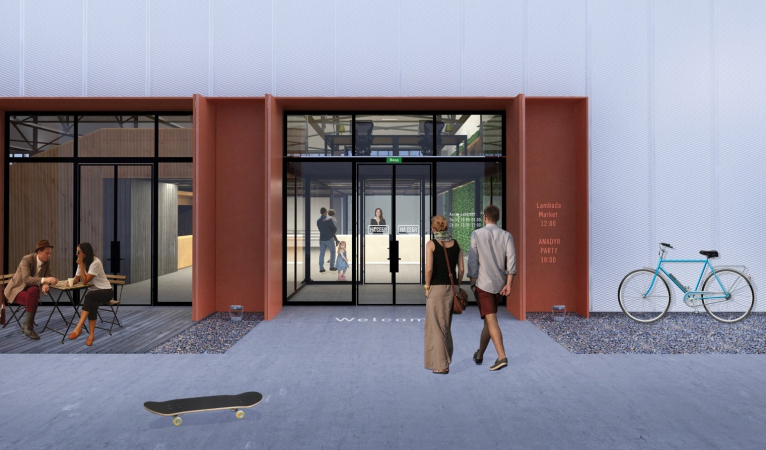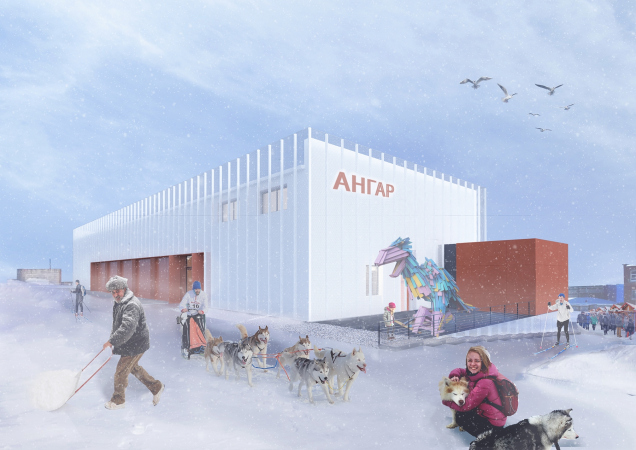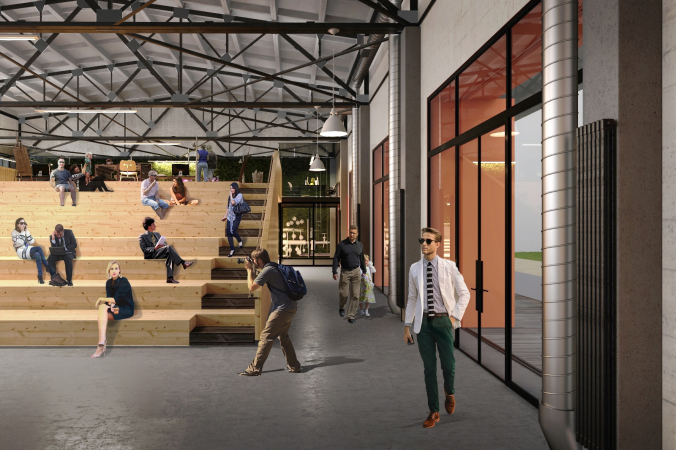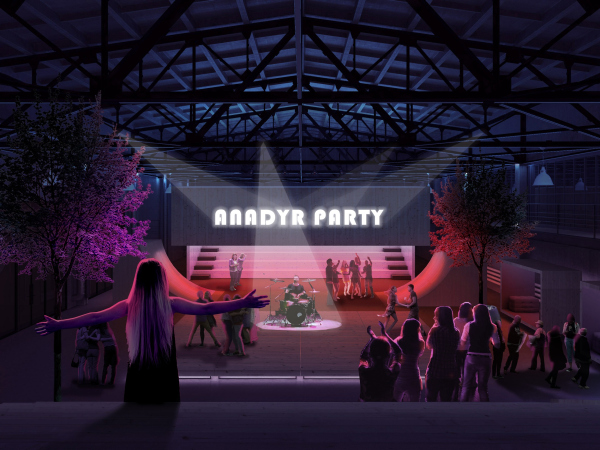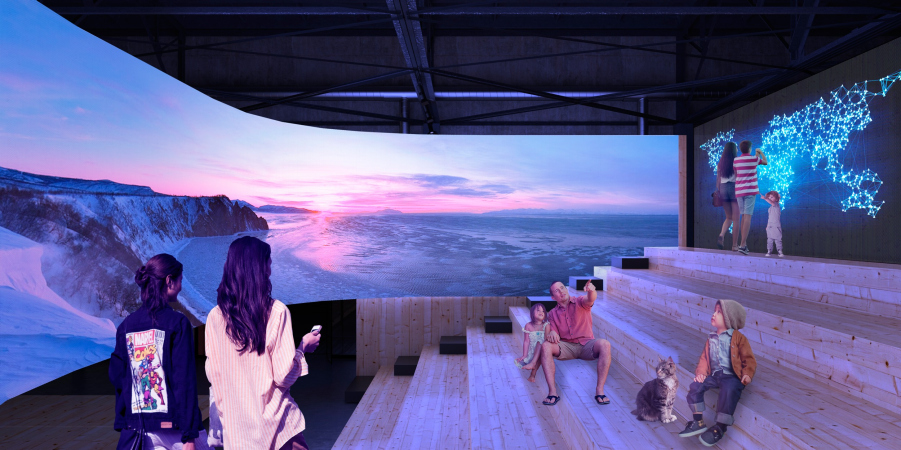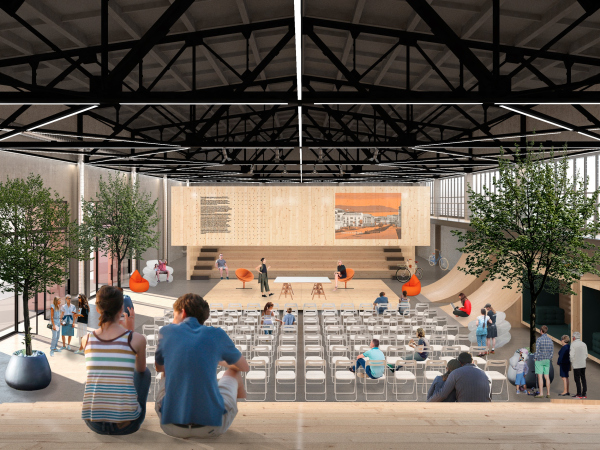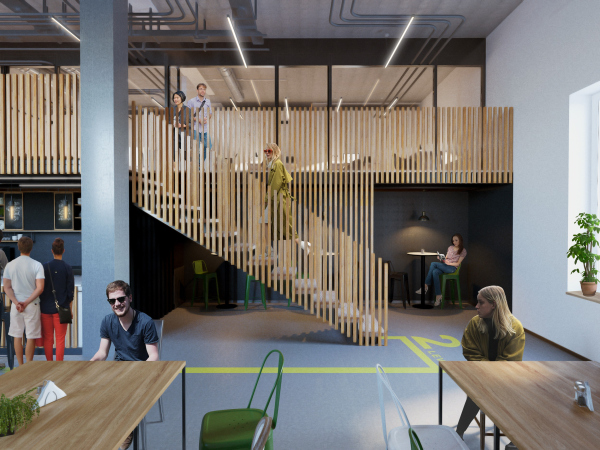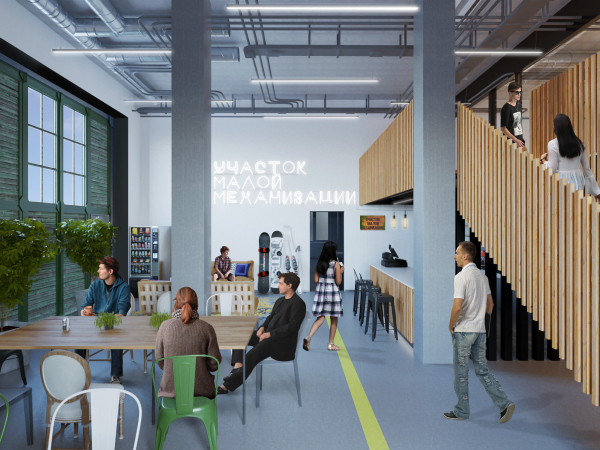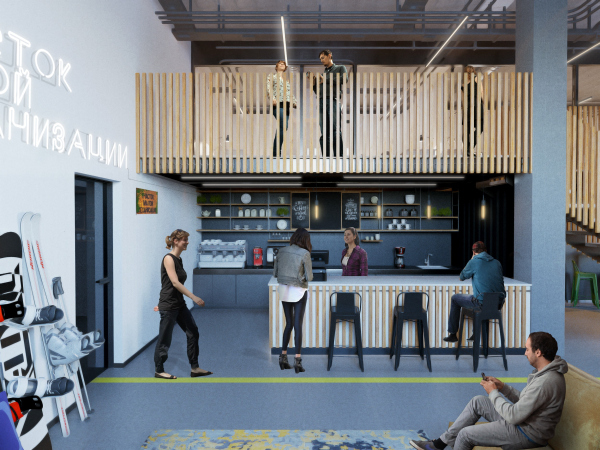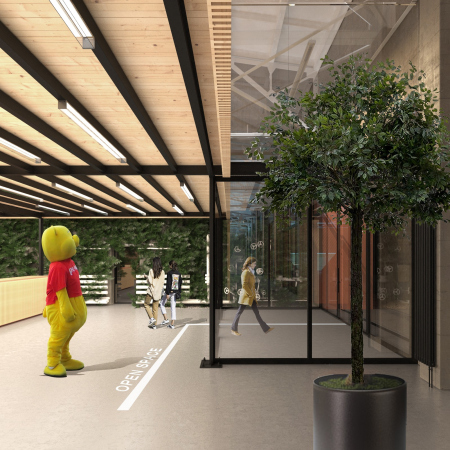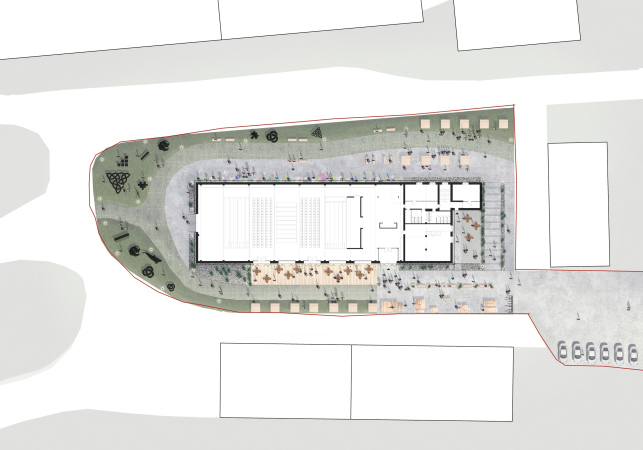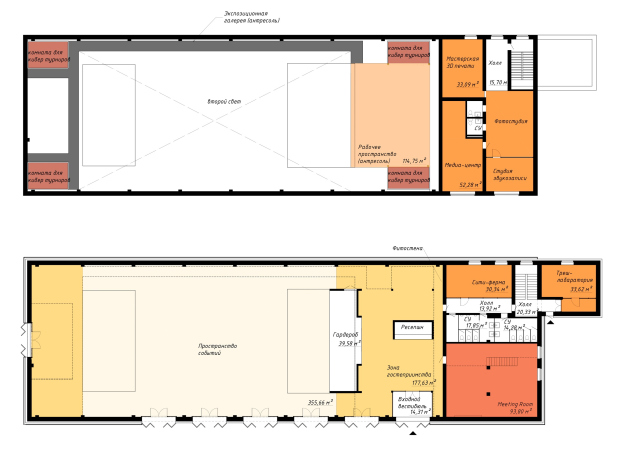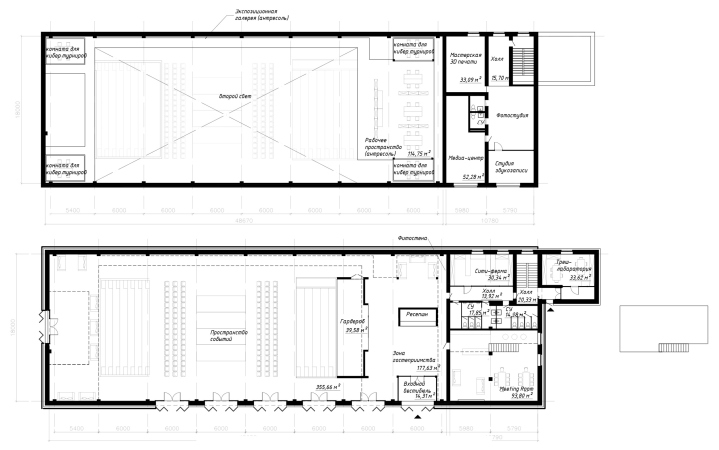Let’s start with the fact that Anadyr is the capital of the Chukotka Autonomous Okrug and the easternmost city of Russia – further on, there is only a couple of villages before the Bering Straits. It’s still about two hundred kilometers to go to reach the Arctic Circle, the sun comes up, well, not at midnight but at 2 a.m. in the morning, but winter sets in somewhere around September. On the other hand, the climate is somewhat softened by the vicinity of the sea – the city is situated in the bay of the Anadyr Gulf.
The “Center” agency started its work in Anadyr being invited by the local government in February this year. Its task was to turn the abandoned building of the former garage on the territory of the Chukotkommunkhoz, an industrial park situated at the edge of town but almost on the very bank of the coastal lake, into a modern innovative public space under the name of ANGAR (“The Hangar”). The “Center” experts came to Anadyr a few times, met with the city council, and, still more importantly, with the local young people to find out more about their needs and tastes, organized focus groups and interviews, as well as analyzed various city locations that were suitable for the project. The project also got its pages on Instagram, Telegram, and VK.
The research showed, on the one hand, some pretty obvious things: the city is really far away, even flights to it are often cancelled, but it still has the governing function as the center of the region. In addition, it is a mining industry center, the average salaries are pretty high here, there are plenty of young people in the city, and the city center is compact and low-rise enough to match, at least in terms of its scale, the ideals of modern urbanism. By the way, let’s take a look at the Yandex photos – the city looks quite alright, the façades of the prefab houses, mostly up to five stories high, have been restored to a healthy state, maybe not always beautiful but tidy anyway; the streets are clean, and the city’s only hotel (at least it seems to be one) looks decent and even modern. The city church is wooden, which only adds to its beauty and charm.
Photographs by Maria Sedletskaya:
The former garage and the future youth culture center ANGAR in Anadyr. The current state
Copyright: Photograph © Maria Sedletskaya
On the other hand, the research elicited a few very important details – the western outskirts of the city are the place where people come to admire the sunsets, i.e. it is already loved by the romantically involved part of the population. Second, in spite of the fact that the city generally has a sufficient number of youth centers of, let’s say, official character, like a “Young Pioneers Palace”, it still lacks a place for informal meetings of young people under a warm roof.
The hangar is situated not far away from the Otke Street – it begins in the center, next to the city council, and belts the entire northern part of the city – there is also a driving and pedestrian access to it but in the context of the industrial park the architects had to highlight the hangar by contrast, at the same time keeping its identity and references to its industrial past. The center had to be an all-season one, warm, and comfortable, with a possibility to get outdoors in summer. The researchers also noted a large number of other details, such as the fact that in winter the snow falling from the building accumulates in the south corner, probably because of the sea winds.
Luckily, the project of the informal youth culture center is supported by the government of the Chukotka Okrug. According to the government, the ANGAR project became a part of the new social and economic Far East policy.

Roman Kopin,
the governor of Chukotka Autonomous Region:
“At our focus groups with the local people and the young activists of our region I many times heard questions about building such a space. The young people of Chukotka have a lot of creative ideas but today they do not have a venue for implementing them. We will have to do some serious work in order to realize this project. We are planning to show the concept at a few forums and discuss the future project with the federal government. This is going to be a youth center of a new format, providing lots of possibilities for personal development and organizing the local young people’s leisure time”.
The experts of the “Center” agency gathered and analyzed both global information – about the social and economic specifics of the city – and the local, about the needs of the future users of the project.

Maria Sedletskaya,
chief analyst at the “Center” agency for strategic development:
“Anadyr is a city of a very peculiar character. You can consider it to be the nation’s remotest city not only because it’s the easternmost city of the Russian Federation lying thousands of kilometers away from the largest cities of the European part of the nation, but also because it’s pretty far away even from the large agglomeration centers of the Far Eastern Federal District and the little towns of the Chukotka Region too.
One of the things that Anadyr lacks is the entertainment infrastructure and entertainment events for young people aged from 14 to 35, devised outside the so-called “cultural programs” and outside of the walls of the municipal governmental organizations. The lack of informational unity and the territorial isolation of Anadyr, together with the global competition among cities makes the deficit of its “own” youth spaces all the more prominent.
Unlike many other cities of Russia’s Extreme North, the central residential part of Anadyr has a rather compact and human-proportionate plan. The peculiarities of territory development include a large stock of production and storage facilities, a large part of which recently fell into disuse. The territory includes the building of “Hangar” (the former garage), and its reconstruction has a huge potential because it will make it possible to transform the vacant building to meet any of the needs of its potential users”.

Sergey Georgievsky,
CEO of the the agency for strategic development “Center”:
We defined the mission of the public space created by us as “creating the optimum conditions for self-realization of young people, their integration into the processes that take place outside the city boundaries, and fostering the culture of social responsibility”. This way, ANGAR must create such an environment that will allow the young people not only to satisfy their various leisure needs but also self-realize themselves in those fields of activity that will be in demand in the future. At the same time, the Mission of the place is broadcast to the outside audience and serves as a basis for gradually increasing the role of the Center – from the level of the city district and Chukotka region to the global level.
In terms of future redevelopment, the most promising territory is the production facilities area in the western part of town, surrounded by residential houses, and a waterfront area with an access to the Anadyr coastal lake – the popular youth location for admiring the sunsets and going for picnics. Including this territory into the life of the city will give an impulse to the development of new kinds of services, will increase the feeling of safety and comfort, and will make it possible to use the territory more effectively, especially if the appropriate engineering infrastructure and transport connection to the city will be maintained”.
The architectural concept of ANGAR youth culture center, 2019
Copyright: © MAParchitects / “Center” agency research
More about the project, though! Having gathered all the information and requests, in order to develop a full-fledged architectural proposal, the “Center” agency invited MAParchitects, whose task was to turn a rank-and-file hangar, built from large reinforced concrete panels, into a warm, cozy, and modern building, noticeable from a distance and attractive, suitable for the development of modern youth culture, multifunctional and transformable, and also not devoid of signs of its previous life, which became an indispensable part of today’s approaches to reconstructing industrial buildings. Such buildings must become convenient, at the same time keeping up their unique identity.

Alexander Poroshkin,
leader of the architectural company MAParchitects:
“When we were working on the project of this all-season youth center, it was crucially important for us to keep up the authenticity of this building, its industrial past, making for the people of Chukotka a so-called “third place” – a place where they could come to in order to have a great time with their friends, maybe listen to a lecture, develop their communicative skills, make their creative plans become a reality and generally diversify their leisure. The future ANGAR center, in addition to its main function, will also become an eventful place that accumulates the young people’s energy and enthusiasm and turns them into useful initiatives”.
Thus, the two most noticeable techniques are determined by the search for an aesthetically pleasing and vibrant image coupled with the down-to-earth heat-insulated walls. The latter is ensured by sandwich panels filled with mineral cotton; a layer of such panels will cover the concrete walls of the hangar, and on the outside the walls will be covered by a grid of punch metal panels, capable of handling some of the wind load, and at the same performing a decorative function. The brightness is also ensured by the contrast between the snow-white walls and the warm red color of the entrance group and the minor volumes. Generally speaking, ANGAR must ultimately look like a rectangular block cut out from snow with an entrance looking like a conditional fireplace, warm and attractive like any housing in these cold latitudes – something that is archetypal for these parts.
The architectural concept of ANGAR youth culture center, 2019
Copyright: © MAParchitects / “Center” agency research
In addition, the architects are widening the entrance, proposing to take apart the brickwork of the old gate – the entrance group gets an extra glass aperture that will be opened in the summertime, letting in more light and widening the connection between the inside and the outside space, and closed in the wintertime with metallic shutters to keep the warmth inside. There is also a terra-cotta-colored depression next to the main entrance that takes in the role of a peculiar modernist portico; it is rather lengthy yet not without industrial allusions – the pylons are interpreted as large double-L beams.
On the other side, the white metallic grid steps rather far away from the walls and grows higher than the roof, clearly indicating the fact that the building is encased in some kind of tight grid subjugated to the rhythm of vertical joints. The semi-transparency is created by the second layer, aka the layer of meanings: in winter, it will make it possible to mount the backlights creating an aurora borealis effect (although, probably, the light will be adjustable, and the dynamic settings will be there as well). In the wintertime, the façades will echo the warm glow of the white nights.
The main merit of the space inside lies in the fact that it is unsupported and rather high, too – 5.8 meters from the floor to the beams and then another 3 meters of height occupied by the metallic beams. The architects are planning to keep them, just as a number of plaques and concrete textured surfaces that remind about the old industrial garage. The plaques may become a part of the trash art exposition – the architects explain – or they will be simply included in the interior design as permanent elements. Another decoration will be the host of pipes with valves and facets – also the heritage of the old industrial garage.
One of the main elements of this project is the open space venue for concerts, lectures, fairs, and the like. This place gets two wooden amphitheaters, a media screen, and a cafe; the transformable space is very flexible and is capable of performing really different functions, even becoming a small skate park. The smaller spaces of the workshops are situated on the perimeter gallery – they can be accessed by staircases, and from the galleries people will be able to watch what’s going on in the open space.
As for the functional program of this building, it is planned to be very diverse. Furthermore, as the analysts claim, the youth center is designed with a view for future development and expansion. Its Instagram account bustles with callings to young people to file in their own ideas on developing the composition of the complex. Currently, it already includes a chill-out, a city farm, a meeting-room, photo and video studios, and a place for cyber sports contests.
Maria Sedletskaya,
chief analyst at the “Center” agency for strategic development:
“What makes this venue different is the fact that we developed the event content and the architectural solutions for zoning the hangar space based on the needs of its future users because it is the young Chukotka activists form the basis for developing the creative potential. These were ideas for creating an open and transformable space, as well as various specialized premises for print works, a media center with an interactive map of Russia, a sound recording studio, photo and video studios, cyber sports contests, grow boxes, a graffiti festival, and whatnot.
The brand events form the calendar schedule depending on the season and the weekly engagement of the premises. Interacting with lots of stakeholders will make it possible to perform lots of useful activities aimed at continuous education, public communications, intellectual pastime, collective usage of assets, and exchange of ideas.
One of the high-profile events presupposes developing the already existing movie festival Zolotoy Voron (“The Golden Raven”), which fills the houses to capacity and attracts participants from the North America, Scandinavia, and the Northern regions of Russia. The list or international and interregional events specifically includes trendy and modern event formats based on the local identity, for example, “Bering-Fest” youth festival. Large-scale open air events will be chiefly held in the summertime – the outdoor exhibition of trash art, a video art competition, etc”.
The project is due to be implemented by the end of 2019 or the beginning of 2020.




